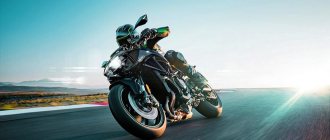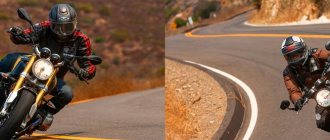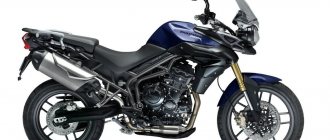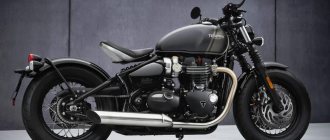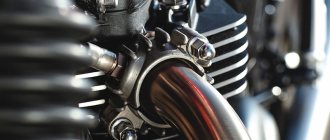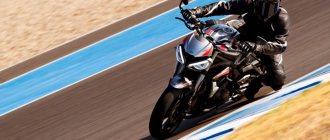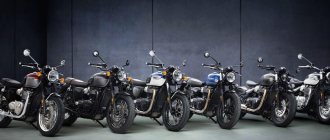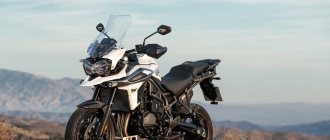It’s hard to say what clicked in the minds of the English engineers at the moment when they decided to create the Triumph Rocket 3. Having received the task of designing a bike that could compete on equal terms with the Harley-Davidson Electra Glide, they approached the matter with all responsibility. And since engine capacity has always been held in high esteem among lovers of chrome and leather, the designers from Foggy Albion went all-in and presented the public with a production motorcycle with the largest engine capacity in the world. Moreover, this decision was made intentionally - as Triumph representatives admitted, Rocket 3 would have received the required technical characteristics with a 1.5-liter engine. Therefore, they decided to “inflate” it to an impressive 2294cc only in order to take away the laurels of the most “cubic” cruiser from the Kawasaki VN2000 Vulcan, and the “one and a half liter” niche was occupied by the Triumph Thunderbird 1600, which was subsequently upgraded to the Thunderbird Storm 1700.
Design
The lack of symmetry in the appearance of the motorcycle is immediately striking. The Triumph Rocket 3 is equipped with a 3-cylinder in-line engine , which in itself is an important part of the design. All three valve covers face the same direction , since the engine is placed longitudinally in the frame, not transversely, and the classic modification has three exhaust pipes, two on one side and one on the other.
The strange appearance is complemented by a dual headlight and the absence of various plastic excesses - Triumph cruisers are traditionally made entirely of good old iron, like Harley-Davidsons. The result turned out to be interesting - some people like the look of Rocket 3, some don’t, but we can undoubtedly say that it turned out to be memorable.
Appearance, distinctive features of Triumph Rocket 3
There is nothing superfluous in the appearance of a cruiser. It looks brutal and stylish. Bright external data is one of the strengths of Rocket 3. The silhouette is given a smart appearance by an openwork aluminum frame with a very compact subframe. The headlights are represented by dual headlights with a DRL pattern, which will not allow the bike to be confused with any other.
In Rocket 3, every component is made at a premium level. This is felt even in the smallest details: aluminum cladding panels, a voluminous logo on the gas tank, a radiator surround, an elegantly folding footrest.
The fork angle is relatively small. This is due to the weight of the cruiser. The edges of the cooling radiator are visible behind the powerful front wheel. Although the tank is voluminous, it fits well into the appearance.
The double seat is separate. The passenger side is located in front of the oval brake light. Both seats are lowered to give stability to the bike. Below them is the glove compartment. The instrument panel is presented in the form of wells with sensors.
Specifications
2.3 liters of engine capacity is a serious bid for victory. But it's not just about the numbers - the motorcycle really works for all the money it costs. And although some design elements in it look controversial, representing a combination of modernity and archaism, overall the bike turned out to be very balanced, if you forget about its monstrous mass. Of course, the Triumph Rocket 3 has technical characteristics that correspond to its enormous weight, but it is still not easy to handle physically.
Engine
In-line three liquid cooling with a displacement of 2294 cc. see, and that says it all. A monstrous engine , more powerful than most city cars, produces 148 hp. and 221 Nm of torque , and all this power is felt already at low revs. In the Touring version, the engine was significantly retuned, gaining 106 hp. in exchange for increased torque. But even in this modification, the acceleration dynamics remain very impressive - the maximum speed of the Triumph Rocket 3 reaches 220 km/h , and the motorcycle accelerates from 0 to 100 km/h in 4 seconds .
Transmission
The gearbox is the most controversial and controversial part of this motorcycle. Distinguished by its rough work, it is as reliable as an anvil, and can only be damaged by a careless attitude towards maintaining the bike. But for some reason it only has 5 steps, while the sixth is sorely missing. What prevented British designers from equipping the Triumph Rocket III Roadster with a modern 6-speed gearbox is a mystery to which there is no answer.
Chassis and brakes
Energy-intensive shock absorbers reliably support this steel carcass on the road, under which the asphalt bends. With a dry weight of 362 kg (the Roadster weighs a little less, and the Touring more), all these kilograms are subjectively felt. The situation is saved by the fact that the engine is shifted downwards, and, accordingly, the center of gravity is too. The shock absorbers match the load - they cope with both extreme loads and bad roads. The brakes are very reliable (two 320 mm discs with 4-piston calipers at the front, one 316 mm disc with a 2-piston caliper at the rear), manufactured by Brembo, and the ABS system . But due to the enormous mass, the braking distance still remains quite long.
Electronics
Cruisers are archaic by definition, and they should have a minimum of electronic filling. In the case of the Triumph Rocket III Roadster, this is the case; no “extra” electronics are provided in it. The generator's power is sufficient to confidently power tuning equipment such as music and additional headlights, if one is installed.
Weight and dimensions
Wide, heavy, long - these three words completely describe the Triumph Rocket 3. With a full tank and body kit, the weight of the motorcycle approaches the 400 kg mark, or even exceeds it. The steering wheel is wide, which creates additional problems in the aisle. Rocket 3 is a model for strong and strong bikers who can handle it.
Controllability
On the move, the bike handles surprisingly well, at least at moderate speeds. But already at 140-150 km/h, due to its mass and aerodynamics of a flying brick, it turns into a cannonball traveling strictly along a straight path, which is also worth taking into account. But as a wife, we would criticize a power cruiser, built for power, for mediocre handling at top speeds, right?
Fuel consumption
The officially declared fuel consumption of the Triumph Rocket 3 is 6.5 liters in the combined cycle. But “mixed cycle” is a very vague concept, and it would be more correct to compare consumption in the city and on the highway. In general, with a quiet ride on the highway, you can even manage 6 liters if you drive no faster than 110-120 km/h, and in the city, lovers of aggressive riding may be surprised to find that the bike easily swallows 10 liters per 100 km . The Roadster modification is especially gluttonous, which has also become famous as a “tire eater” - due to the crazy torque, the rear tires wear out quickly, within 7-10 thousand km, and some bikers change them 2-3 times per season.
Electronics to the maximum:
TFT instrument panel of the second generation with the possibility of customization and individual settings for the driver. The nice thing is that there is an adjustment for the angle of the panel so that the driver can adjust and read it better, and also adjust it according to the weather so that there is no glare.
The stock anti-lock braking system, the effectiveness of which is ensured by a new control unit - IMU. To prevent slipping of the rear wheel and temporarily reducing torque transmission, traction control is provided.
To make the most of the bike's capabilities, you can use several control modes - Road, Sport, Rain and the Rider mode, which is individually customizable for the driver.
Both versions are equipped with full LED optics - headlights, brake lights, side lights and turn signals. A distinctive feature can be considered the distinctive DRL pattern in the twin round headlights.
Since the motorcycle weighs quite a bit, an assistant will be very useful when starting uphill. This system prevents the motorcycle from rolling away when standing on a steep incline. It is activated using the front brake lever. Let's add here a cruise control system, keyless entry and a USB outlet. Decent package. It's a shame it doesn't have a quickshifter...
Additional features include a quickshifter and GoPro integration. An interesting solution was the close work between the manufacturer and Google. As a result, you can connect the navigation system via an additional Bluetooth module using a special free application. An additional option is an on-board assistant that monitors tire pressure - TPMS. Phone integration and an app are available that allows you to manage the bike's settings.
Motorcycle price
The cost greatly depends on the year of manufacture. And in this case, this is even good, the Triumph Rocket 3 is a specific bike, so a lot of people bought it “for show-off”, and not for real trips. Thanks to this, it is quite possible to find an inexpensive 15-year-old copy with a mileage of 20-25 thousand kilometers, not even twisted. The most budget options start from about 0.5 million rubles , and the latest copies of the last years of production are now three times more expensive. Not cheap, of course, but the technical characteristics inherent in the Triumph Rocket III are worth every penny paid for it.
Repair and tuning
Fortunately for budget-conscious bikers, the design of the Triumph Rocket 3 is quite simple, so if you wish, you can service the bike yourself without spending extra money on motorcycle services. Moreover, not all of them are familiar with this model, and it is somewhat scary to trust a motorcycle to people who may have only seen Triumph motorcycles in the picture.
Repair
Given the skills, tools and the right space, you can assemble and disassemble the Triumph Rocket 3 Roadster yourself, although you'll need the help of a couple of sturdy friends to move the heavy motor. But you can still repair a motorcycle quite inexpensively.
Spare parts
Dealers always have original spare parts, but they are not cheap. There are non-original ones, but they are few and far between, and you will most likely have to order them on Ebay or in foreign online stores. Prices for non-original spare parts are lower than for dealer parts, but not by much.
Tuning
The weak point of the Triumph Rocket III Roadster is the lack of tuning. Despite its worldwide popularity, the bike did not become a “people's favorite” like the Yamaha V-Max 1200, probably due to its high price. Therefore, there is practically no tuning from third-party manufacturers, and the Triumph catalog is a thin brochure, the prices of which can make the hair on end of an honest Russian motorcyclist stand on end. And not only on the head.
Yacht
If you are worried about the cost of maintaining a yacht, then you are not ready to buy it. If, when you see the Triumph Rocket III, you begin to be tormented by philosophical questions from the series “why, for what, to whom and who is to blame,” then you are also not mature enough to buy such a motorcycle.
Timeless and as monumental as English snobbery, Triumph Rocket III is created for true gourmets. There are such characters that they always drink never-cheap cognac from only one brand. They can often be seen with an expensive cigar, the cost of which is comparable to the monthly salaries of many state employees.
And these people, who obviously have the opportunity to be “in trend,” often drive “wrong” cars that are incomprehensible to many around them, for example, Jaguar or Aston Martin. However, the listed signs are not at all obligatory - rather, the unifying factor for all these gentlemen can be called the fact that they, without a doubt, know a lot about good things in this life - and can enjoy them.
Therefore, my following expert assessments about slightly damped, “lazy” handling, a relatively modest maximum speed (about 200 km/h) and not the most comfortable ergonomics of the driver’s seat in relation to the Triumph Rocket III will not have any significance. Do you think some lord in an ancient family estate is very interested in the opinion of his servants about the weather?..
Motorcycle modifications
- Rocket III . The classic version, produced since 2004 and currently discontinued. All other modifications have much in common with it.
- Classic . Produced since 2006, it differed from its “regular” brother in the model range by platforms instead of footpegs, a different exhaust and steering wheel.
- Roadster . The only modification of Triumph Rocket 3 currently being produced. The Roadster first went on sale in 2010, offering bikers a retuned engine with increased power, a different exhaust system and minor design differences.
- Tourer . Produced only in 2007, it differed from the classic modification in the presence of a windshield, panniers, passenger backrest and trunk, as well as a color scheme.
- Touring . Version with a retuned engine (lower power, higher torque), tank-mounted instrument panel, fuel level indicator, narrower rims, windshield and Kayaba rear shock absorbers. Touring was discontinued in 2021.
Advantages and disadvantages
Such a charismatic and unique bike cannot but have objective advantages and disadvantages. All of them are continuations of this crazy concept - a brutally powerful and incredibly heavy cruiser, the creators of which prioritized dynamics and torque sufficient to move a locomotive.
Advantages
- Crazy acceleration dynamics coupled with huge torque available at low revs.
- Incredible appearance , which immediately attracts the attention of others to the motorcycle and its owner.
- Comfortable fit and thoughtful ergonomics. While riding this bike, a biker of any size will feel comfortable and comfortable.
- High reliability . No motorcycle in the world is perfect, but the Triumph Rocket 3 Roadster deservedly enjoys its reputation as a reliable and trouble-free bike.
- Large power reserve . With quiet driving on the highway, you can travel 300-350 km without refueling.
Flaws
- Long braking distance , despite tenacious brakes. This is a consequence of the huge mass - the laws of physics cannot be fooled.
- High mass . In addition, the Triumph Rocket III is wide, so it is advisable for the pilot who dares to sit on it to be not only physically strong enough, but also long-legged.
- High fuel consumption . In the combined cycle, it can easily exceed 8 liters per hundred.
- Lack of sixth gear in the transmission.
- A peculiar design . In some motorcycle services, the technicians have never dealt with this model, and therefore are not able to understand it.
Summary:
The Rocket 3 R model is needed by those who love big and fast motorcycles, for whom sporting qualities come to the fore. But the Rocket 3 GT is more comfortable; the seating position is slightly lower, with forward footpegs and a windshield, the bike becomes more convenient for long journeys.
The manufacturer took into account all the wishes of users in the update, eliminated shortcomings, and made the motorcycle more obedient. Now he is more flexible and predictable than ever. There were complaints about previous models, they say, the power and weight could behave on the road as they wanted, but now the reviews are much more welcoming, and there are no limits to the admiration from the first tests.
Both models can be described for a long time, especially if you take into account all the offers that the manufacturer can install. The cost of new motorcycles is within a radius of two and a half million, plus or minus a hundred thousand for possible personal wishes in the configuration.
The motorcycle is not for everyone, since you still need to cope with its volume and dimensions, and for that kind of money there are enough competitors breathing down your neck. Although you need to try to catch up with the monster with a 2.5 liter engine.
Owner reviews
The spendthrift is absolutely crazy, but not for the wimpy, if he manages to put pressure on it, it won’t be easy to lift it. In static conditions, it’s generally cast iron, it’s hard to move, and it’s hard to roll around a parking lot, although in the photo it doesn’t seem so huge at all. On the go, it steers easily, the size and weight are not felt. It eats a lot, but it depends on how you heat it, I managed to fit in 6 liters, I pour 92 benz. Arthur, St. Petersburg, Triumph Rocket III '2007.
I was looking for a motorcycle for long-distance travel, I didn’t want to take the Electric Train for my own reasons, Indian was expensive and had almost zero tuning, Victory Vision Tour - there was no information. As a result, in 2021 I took a 2016 Rocket Touring with a mileage of 22k, I have not regretted it even once. In two seasons, I put almost 60k on the wheels, drove from Moscow to Gibraltar and Tenerife, drove alone, and with a passenger, both on good roads and on broken ones. Not a motorcycle, but a tank, rushing everywhere, when you turn the right handle, it instantly teleports, and pieces of asphalt begin to fly from under the rear wheel. Vitaly, Moscow, Triumph Rocket 3 Touring '2016.
I’ve been dreaming about the Rocket for a long time, I switched to it from the XV1900 Stratoliner, but either the skis don’t work, or I haven’t tried all the delights of the 2.3-liter inline three. The bike is heavy, accelerates really briskly, but is clumsy, like a rhinoceros on ice. I left for the season, sold it, bought an XV1900 Raider. The experience was interesting, but nothing more. Sergey, Voronezh, Triumph Rocket III Roadster '2012.
Similar models
There are no motorcycles similar in all respects to the Triumph Rocket III - it is truly unique. At least conditionally, it can only be compared with other power cruisers, but even in this case it is worth remembering that there are still more differences between these bikes than similarities.
- Yamaha V-Max 1700 . The embodiment of two-wheeled anger, accelerating at the first cosmic speed when the gas is opened.
- Harley-Davidson V-Rod. This motorcycle harmoniously combines American classics and proprietary technologies from Porsche, which took part in the development of the Revolution engine.
- Ducati Diavel. Stylish and expensive power cruiser from sunny Italy. In terms of technical characteristics, however, Diavel is inferior to all competitors.
Style comes first
We can rant all day about the functionality of these masculine two-wheelers, but how they look is just as important as how they perform. The V-Max, when it arrived, set a new bar for masculine styling with its artistic V-4, mantis-like tank and predatory profile. And to be a true successor, the Rocket III needs to look just as aggressive if it's going to set a new standard in that style.
The Rocket also has to live up to its inline-three architecture. A comparison of Rocket's initial concept drawings and the final production car reveals one glaring difference: the exhaust system is now on the right side of the engine. The designers' drawings show beautiful pipes running forward and turning towards the rear wheel. The production version has potbellied pipes that go straight down, reminiscent more of a Massey-Ferguson than a Harley-Davidson.
The Triumph team says the short, straight manifolds are a result of practical ergonomics: they have to be that way. In other words, they should not rub against the rider's boots. And in the matter of controlling heat transfer, they have succeeded greatly; we noticed only a few thermal units leaking through the complex thermal protection system...
The surface of the engine can also be a source of some controversy; its silver finish and fin design may be good from an engineering standpoint, but the engine looks like a Celica that's lost a cylinder. We often criticize cruiser stylists for installing false fins on a liquid-cooled engine to give a more “traditional” look. And we'd probably trash Triumph if it did the same, given that we're inexperienced and inconsistent critics.
We suspect that both Vance and Hines are rushing to design manifolds and pipes in more seductive shapes for the Rocket III, and that in the future the Rocket will be fitted with black-painted engines to dull its shine.
Based on our meticulous analysis, the Rocket III is a definite hit in the eyes of the general public, just as the V-Max was when it hit the streets in '85. Rocket III received almost the same positive reaction.
FAQ
- Is it possible to pick up this motorcycle if you suddenly drop it? Yes, it’s real, and you don’t need to be Superman to do it. But a fair amount of physical strength will still be required.
- Is he really trying to roll over on his side at idle? The moment of inertia of the pistons pulls it to the side, but not so much that it creates inconvenience. And you can only feel it by standing still.
- Is Rocket 3 suitable for long-range driving? Quite, although in this case it is better not to buy the Roadster modification - it is designed to squeeze out adrenaline, and not for highways.
Summing up
In many ways, the Rocket III is not a competitor to the blessed V-Max, but rather an evolution of it. The Yamaha was a sensation for three reasons: it looked great, it was crazy fast, and it performed like an urban fighter jet. He was handsome, crazy and smart. Everyone at the same time. But gradually the idea of the ultimate power cruiser began to be associated with a bigger, slower, more determined image.
Rocket III is no less an engineering achievement - but for an audience that wants more than just blazing speed. Size, sound and looks are everything modern cruiser riders need. And the actual speed is ranked fourth at best.
Conclusion
Triumph Rocket III Roadster is the main heavyweight in the world of motorcycles . Possessing power comparable to a sportbike, it is distinguished by its impressive dimensions and large weight . For obvious reasons, this mastodon feels a little out of place on tight city streets, but experienced pilots can easily thread traffic jams on it. But inexperienced people shouldn’t get on this 2.3-liter monster - it won’t lead to any good.
Specifications
| Maximum engine power: | 148 HP |
| Torque: | 221 N•m at 2750 rpm Nm |
| Working volume: | 2294 cm3 |
| Motor type (cylinder arrangement, number of strokes): | 3-cylinder, 4-stroke, In-line |
| Number of cylinders: | 3 |
| Number of valves: | |
| Intake type (Injector / Carburetor): | |
| Bore and stroke: | |
| Starting system (Electric starter, kick starter): | |
| Maximum speed in km/h: | 220 km/h |
| Cooling system: | Liquid |
| Transmission (gearbox): | 5-speed, Manual |
| Clutch (Dry / Wet): | |
| Drive unit: | Cardan |
| Frame: | Steel tubular |
| Chassis | |
| Suspension (front/rear travel): | |
| Brakes (Front/Rear): | |
| Wheels / Tires / Rubber: | |
| Dimensions and weight | |
| Dimensions (Length / Width): | |
| Seat height: | |
| Ground clearance: | |
| Curb weight: | |
| Wheelbase: | 1695 mm |
| Weight: | 367 kg |
| Fuel tank capacity: | 24 l. |
| Battery capacity: | |
| Year of release: | |
| Country of Origin: |

